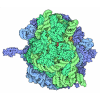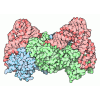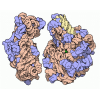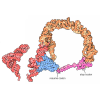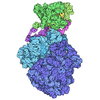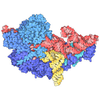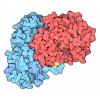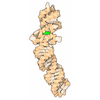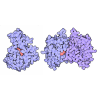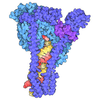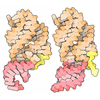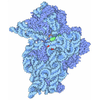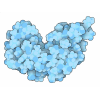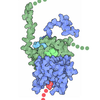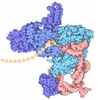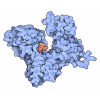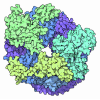[English] 日本語
 Yorodumi
Yorodumi- PDB-8xsy: Cryo-EM structure of the human 80S ribosome with Tigecycline, e-t... -
+ Open data
Open data
- Basic information
Basic information
| Entry | Database: PDB / ID: 8xsy | ||||||
|---|---|---|---|---|---|---|---|
| Title | Cryo-EM structure of the human 80S ribosome with Tigecycline, e-tRNA and CCDC124 (40S head Swivelled) | ||||||
 Components Components |
| ||||||
 Keywords Keywords | RIBOSOME / Tigecycline / antibiotic / CCDC124 | ||||||
| Function / homology |  Function and homology information Function and homology informationribosome hibernation / translation elongation factor binding / PML body organization / SUMO binding / embryonic brain development / translation at presynapse / exit from mitosis / response to insecticide / eukaryotic 80S initiation complex / negative regulation of protein neddylation ...ribosome hibernation / translation elongation factor binding / PML body organization / SUMO binding / embryonic brain development / translation at presynapse / exit from mitosis / response to insecticide / eukaryotic 80S initiation complex / negative regulation of protein neddylation / optic nerve development / regulation of translation involved in cellular response to UV / axial mesoderm development / negative regulation of formation of translation preinitiation complex / regulation of G1 to G0 transition / ribosomal protein import into nucleus / negative regulation of endoplasmic reticulum unfolded protein response / oxidized pyrimidine DNA binding / response to TNF agonist / positive regulation of base-excision repair / protein-DNA complex disassembly / positive regulation of respiratory burst involved in inflammatory response / positive regulation of intrinsic apoptotic signaling pathway in response to DNA damage by p53 class mediator / positive regulation of intrinsic apoptotic signaling pathway in response to DNA damage / positive regulation of gastrulation / 90S preribosome assembly / retinal ganglion cell axon guidance / protein tyrosine kinase inhibitor activity / nucleolus organization / positive regulation of endodeoxyribonuclease activity / IRE1-RACK1-PP2A complex / positive regulation of Golgi to plasma membrane protein transport / TNFR1-mediated ceramide production / negative regulation of RNA splicing / negative regulation of DNA repair / GAIT complex / positive regulation of DNA damage response, signal transduction by p53 class mediator / TORC2 complex binding / alpha-beta T cell differentiation / G1 to G0 transition / supercoiled DNA binding / neural crest cell differentiation / NF-kappaB complex / cysteine-type endopeptidase activator activity involved in apoptotic process / oxidized purine DNA binding / middle ear morphogenesis / positive regulation of ubiquitin-protein transferase activity / negative regulation of intrinsic apoptotic signaling pathway in response to hydrogen peroxide / negative regulation of bicellular tight junction assembly / regulation of establishment of cell polarity / ubiquitin-like protein conjugating enzyme binding / rRNA modification in the nucleus and cytosol / negative regulation of phagocytosis / erythrocyte homeostasis / Formation of the ternary complex, and subsequently, the 43S complex / cytoplasmic side of rough endoplasmic reticulum membrane / negative regulation of ubiquitin protein ligase activity / laminin receptor activity / protein kinase A binding / homeostatic process / ion channel inhibitor activity / Ribosomal scanning and start codon recognition / pigmentation / Translation initiation complex formation / positive regulation of mitochondrial depolarization / macrophage chemotaxis / lung morphogenesis / positive regulation of T cell receptor signaling pathway / fibroblast growth factor binding / negative regulation of Wnt signaling pathway / positive regulation of natural killer cell proliferation / monocyte chemotaxis / negative regulation of translational frameshifting / TOR signaling / Protein hydroxylation / BH3 domain binding / SARS-CoV-1 modulates host translation machinery / positive regulation of activated T cell proliferation / iron-sulfur cluster binding / regulation of adenylate cyclase-activating G protein-coupled receptor signaling pathway / cellular response to ethanol / regulation of cell division / mTORC1-mediated signalling / Peptide chain elongation / Selenocysteine synthesis / positive regulation of intrinsic apoptotic signaling pathway by p53 class mediator / Formation of a pool of free 40S subunits / cellular response to actinomycin D / endonucleolytic cleavage to generate mature 3'-end of SSU-rRNA from (SSU-rRNA, 5.8S rRNA, LSU-rRNA) / Eukaryotic Translation Termination / blastocyst development / positive regulation of GTPase activity / SRP-dependent cotranslational protein targeting to membrane / negative regulation of ubiquitin-dependent protein catabolic process / Response of EIF2AK4 (GCN2) to amino acid deficiency / protein serine/threonine kinase inhibitor activity / ubiquitin ligase inhibitor activity / Viral mRNA Translation / positive regulation of signal transduction by p53 class mediator / negative regulation of respiratory burst involved in inflammatory response Similarity search - Function | ||||||
| Biological species |  Homo sapiens (human) Homo sapiens (human) | ||||||
| Method | ELECTRON MICROSCOPY / single particle reconstruction / cryo EM / Resolution: 3 Å | ||||||
 Authors Authors | Li, X. / Wang, M. / Cheng, J. | ||||||
| Funding support | 1items
| ||||||
 Citation Citation |  Journal: Nat Commun / Year: 2024 Journal: Nat Commun / Year: 2024Title: Structural basis for differential inhibition of eukaryotic ribosomes by tigecycline. Authors: Xiang Li / Mengjiao Wang / Timo Denk / Robert Buschauer / Yi Li / Roland Beckmann / Jingdong Cheng /   Abstract: Tigecycline is widely used for treating complicated bacterial infections for which there are no effective drugs. It inhibits bacterial protein translation by blocking the ribosomal A-site. However, ...Tigecycline is widely used for treating complicated bacterial infections for which there are no effective drugs. It inhibits bacterial protein translation by blocking the ribosomal A-site. However, even though it is also cytotoxic for human cells, the molecular mechanism of its inhibition remains unclear. Here, we present cryo-EM structures of tigecycline-bound human mitochondrial 55S, 39S, cytoplasmic 80S and yeast cytoplasmic 80S ribosomes. We find that at clinically relevant concentrations, tigecycline effectively targets human 55S mitoribosomes, potentially, by hindering A-site tRNA accommodation and by blocking the peptidyl transfer center. In contrast, tigecycline does not bind to human 80S ribosomes under physiological concentrations. However, at high tigecycline concentrations, in addition to blocking the A-site, both human and yeast 80S ribosomes bind tigecycline at another conserved binding site restricting the movement of the L1 stalk. In conclusion, the observed distinct binding properties of tigecycline may guide new pathways for drug design and therapy. | ||||||
| History |
|
- Structure visualization
Structure visualization
| Structure viewer | Molecule:  Molmil Molmil Jmol/JSmol Jmol/JSmol |
|---|
- Downloads & links
Downloads & links
- Download
Download
| PDBx/mmCIF format |  8xsy.cif.gz 8xsy.cif.gz | 4.9 MB | Display |  PDBx/mmCIF format PDBx/mmCIF format |
|---|---|---|---|---|
| PDB format |  pdb8xsy.ent.gz pdb8xsy.ent.gz | Display |  PDB format PDB format | |
| PDBx/mmJSON format |  8xsy.json.gz 8xsy.json.gz | Tree view |  PDBx/mmJSON format PDBx/mmJSON format | |
| Others |  Other downloads Other downloads |
-Validation report
| Summary document |  8xsy_validation.pdf.gz 8xsy_validation.pdf.gz | 2.6 MB | Display |  wwPDB validaton report wwPDB validaton report |
|---|---|---|---|---|
| Full document |  8xsy_full_validation.pdf.gz 8xsy_full_validation.pdf.gz | 2.7 MB | Display | |
| Data in XML |  8xsy_validation.xml.gz 8xsy_validation.xml.gz | 372.7 KB | Display | |
| Data in CIF |  8xsy_validation.cif.gz 8xsy_validation.cif.gz | 645.3 KB | Display | |
| Arichive directory |  https://data.pdbj.org/pub/pdb/validation_reports/xs/8xsy https://data.pdbj.org/pub/pdb/validation_reports/xs/8xsy ftp://data.pdbj.org/pub/pdb/validation_reports/xs/8xsy ftp://data.pdbj.org/pub/pdb/validation_reports/xs/8xsy | HTTPS FTP |
-Related structure data
| Related structure data |  38630MC  8k2aC  8k2bC  8k2cC  8k2dC  8k82C  8xsxC  8xszC  8xt0C  8xt1C  8xt2C  8xt3C  8yooC  8yopC M: map data used to model this data C: citing same article ( |
|---|---|
| Similar structure data | Similarity search - Function & homology  F&H Search F&H Search |
- Links
Links
- Assembly
Assembly
| Deposited unit | 
|
|---|---|
| 1 |
|
- Components
Components
-RNA chain , 5 types, 5 molecules L5L7L8S2CC
| #1: RNA chain | Mass: 1640182.000 Da / Num. of mol.: 1 / Source method: isolated from a natural source / Source: (natural)  Homo sapiens (human) / References: GenBank: 86475748 Homo sapiens (human) / References: GenBank: 86475748 |
|---|---|
| #2: RNA chain | Mass: 38998.078 Da / Num. of mol.: 1 / Source method: isolated from a natural source / Source: (natural)  Homo sapiens (human) / References: GenBank: 23899 Homo sapiens (human) / References: GenBank: 23899 |
| #3: RNA chain | Mass: 50449.812 Da / Num. of mol.: 1 / Source method: isolated from a natural source / Source: (natural)  Homo sapiens (human) / References: GenBank: 555853 Homo sapiens (human) / References: GenBank: 555853 |
| #49: RNA chain | Mass: 602752.875 Da / Num. of mol.: 1 / Source method: isolated from a natural source / Source: (natural)  Homo sapiens (human) / References: GenBank: 36162 Homo sapiens (human) / References: GenBank: 36162 |
| #85: RNA chain | Mass: 24231.510 Da / Num. of mol.: 1 / Source method: isolated from a natural source / Source: (natural)  Homo sapiens (human) / References: GenBank: 174924 Homo sapiens (human) / References: GenBank: 174924 |
+60S ribosomal protein ... , 42 types, 42 molecules LALBLCLDLELFLGLHLJLLLMLNLOLPLQLRLSLTLULVLWLXLYLZLaLbLcLdLeLf...
-Large ribosomal subunit protein ... , 2 types, 2 molecules LILs
| #12: Protein | Mass: 24630.061 Da / Num. of mol.: 1 / Source method: isolated from a natural source / Source: (natural)  Homo sapiens (human) / References: UniProt: P27635 Homo sapiens (human) / References: UniProt: P27635 |
|---|---|
| #46: Protein | Mass: 34309.418 Da / Num. of mol.: 1 / Source method: isolated from a natural source / Source: (natural)  Homo sapiens (human) / References: UniProt: P05388 Homo sapiens (human) / References: UniProt: P05388 |
-Protein , 6 types, 6 molecules LmSgSfCACBCE
| #41: Protein | Mass: 14771.411 Da / Num. of mol.: 1 / Source method: isolated from a natural source / Source: (natural)  Homo sapiens (human) / References: UniProt: P62987 Homo sapiens (human) / References: UniProt: P62987 |
|---|---|
| #70: Protein | Mass: 35115.652 Da / Num. of mol.: 1 / Source method: isolated from a natural source / Source: (natural)  Homo sapiens (human) / References: UniProt: P63244 Homo sapiens (human) / References: UniProt: P63244 |
| #82: Protein | Mass: 18004.041 Da / Num. of mol.: 1 / Source method: isolated from a natural source / Source: (natural)  Homo sapiens (human) / References: UniProt: P62979 Homo sapiens (human) / References: UniProt: P62979 |
| #83: Protein | Mass: 43851.879 Da / Num. of mol.: 1 / Source method: isolated from a natural source / Source: (natural)  Homo sapiens (human) / References: UniProt: Q9UQ80 Homo sapiens (human) / References: UniProt: Q9UQ80 |
| #84: Protein | Mass: 45051.504 Da / Num. of mol.: 1 / Source method: isolated from a natural source / Source: (natural)  Homo sapiens (human) / References: UniProt: Q8NC51 Homo sapiens (human) / References: UniProt: Q8NC51 |
| #86: Protein | Mass: 25890.377 Da / Num. of mol.: 1 / Source method: isolated from a natural source / Source: (natural)  Homo sapiens (human) / References: UniProt: Q96CT7 Homo sapiens (human) / References: UniProt: Q96CT7 |
+40S ribosomal protein ... , 31 types, 31 molecules SASBSDSESFSHSISKSLSPSQSRSSSTSUSVSXSaScSdSCSGSJSMSNSOSWSYSZSbSe
-Non-polymers , 3 types, 271 molecules 
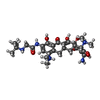



| #87: Chemical | ChemComp-MG / #88: Chemical | ChemComp-T1C / #89: Chemical | ChemComp-ZN / |
|---|
-Details
| Has ligand of interest | Y |
|---|
-Experimental details
-Experiment
| Experiment | Method: ELECTRON MICROSCOPY |
|---|---|
| EM experiment | Aggregation state: PARTICLE / 3D reconstruction method: single particle reconstruction |
- Sample preparation
Sample preparation
| Component | Name: 80S ribosome with tigecycline, E-tRNA and CCDC124 / Type: RIBOSOME / Entity ID: #1-#86 / Source: NATURAL |
|---|---|
| Source (natural) | Organism:  Homo sapiens (human) Homo sapiens (human) |
| Buffer solution | pH: 7.4 |
| Specimen | Embedding applied: NO / Shadowing applied: NO / Staining applied: NO / Vitrification applied: YES |
| Specimen support | Grid material: COPPER / Grid mesh size: 300 divisions/in. / Grid type: Quantifoil R1.2/1.3 |
| Vitrification | Cryogen name: ETHANE |
- Electron microscopy imaging
Electron microscopy imaging
| Experimental equipment |  Model: Titan Krios / Image courtesy: FEI Company |
|---|---|
| Microscopy | Model: FEI TITAN KRIOS |
| Electron gun | Electron source:  FIELD EMISSION GUN / Accelerating voltage: 300 kV / Illumination mode: FLOOD BEAM FIELD EMISSION GUN / Accelerating voltage: 300 kV / Illumination mode: FLOOD BEAM |
| Electron lens | Mode: BRIGHT FIELD / Nominal defocus max: 2500 nm / Nominal defocus min: 1000 nm |
| Specimen holder | Cryogen: NITROGEN |
| Image recording | Electron dose: 50 e/Å2 / Film or detector model: FEI FALCON IV (4k x 4k) |
- Processing
Processing
| EM software |
| ||||||||||||||||||||||||
|---|---|---|---|---|---|---|---|---|---|---|---|---|---|---|---|---|---|---|---|---|---|---|---|---|---|
| CTF correction | Details: Relion / Type: PHASE FLIPPING AND AMPLITUDE CORRECTION | ||||||||||||||||||||||||
| 3D reconstruction | Resolution: 3 Å / Resolution method: FSC 0.143 CUT-OFF / Num. of particles: 46089 / Symmetry type: POINT | ||||||||||||||||||||||||
| Atomic model building | Protocol: RIGID BODY FIT / Space: REAL | ||||||||||||||||||||||||
| Atomic model building | PDB-ID: 6Z6M Accession code: 6Z6M / Source name: PDB / Type: experimental model |
 Movie
Movie Controller
Controller



















 PDBj
PDBj